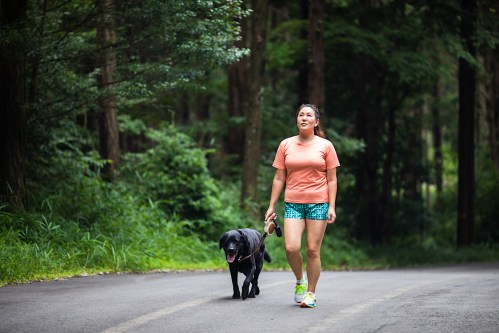Why Walking Is Always My Cool Down and an Exercise Physiologist Says It Should Be Yours Too
An exercise physiologist explains that walking is a good cool down because of all the ways it helps your body get back to baseline.

Whether I’m running or doing strength training, I always end my workouts with a walk—my dog pretty much demands it at this point. But she’s right to want me to keep up this routine because there are benefits to an active cool down, specifically one that involves walking.
Experts in This Article
exercise physiologist and certified personal trainer
During this post-workout stroll, I start to catch my breath, feel my legs unwind, and my heart rate go back to normal. My mind clears, and I sort of feel like I’m in a peaceful daze. After about five or 10 minutes, I feel ready to come home and have some water. Workout: Done.
It turns out the sort of movement I’m doing during those walks, an active cool down, is one of the best ways I can help my body recover and safely come back to baseline levels after exercise. “It’s basically the difference between slamming on the brakes and coasting to a gradual stop,” says exercise physiologist Sharon Gam, PhD, CSCS. “That gradual transition is going to be easier on your body.”
When you exercise, explains Dr. Gam, your body’s fight or flight stress response activates. A big part of recovery is switching from that response (the sympathetic nervous system), to the parasympathetic nervous system, which is the mode we want to be functioning in most of the time.
“After exercise, a low-intensity activity, something like walking, could help to prompt your body to tone down that fight or flight response, and then start to ramp up the rest and recover response,” Dr. Gam says. Your body can make that switch on its own, but an activity like walking will help the transition happen more smoothly and quickly.
Research shows that an active recovery of about five to 15 minutes can also help reduce levels of lactic acid, a substance associated with feelings of fatigue and soreness that builds up in your bloodstream during exercise, and bring your pH back to normal levels. All forms of active cool downs do this, but Dr. Gam thinks that the elements of walking could be specifically beneficial.
“Walking is a particularly good way to do a cool down because you’re in an upright posture, but it’s also a rhythmic activity,” she says. “That’s really good at helping blood flow back up to your heart and your brain,” which is what the cool down process requires.
There are mental upsides to walking, too, like helping to reduce brain fog, that make it well suited as a form of active cool down. Personally, I’ve noticed that my mind feels particularly hazy post-workout. This makes sense to Dr. Gam, who says blood flow gets redistributed in your brain, as well as your body in the minutes, after exercising, so you are thinking a little bit differently. That makes the cool down a time for you to mentally center yourself. Because of this, and all the other benefits to walking after exercise, I won’t be disappointing my dog any time soon.
Sign Up for Our Daily Newsletter
Get all the latest in wellness, trends, food, fitness, beauty, and more delivered right to your inbox.
Got it, you've been added to our email list.










